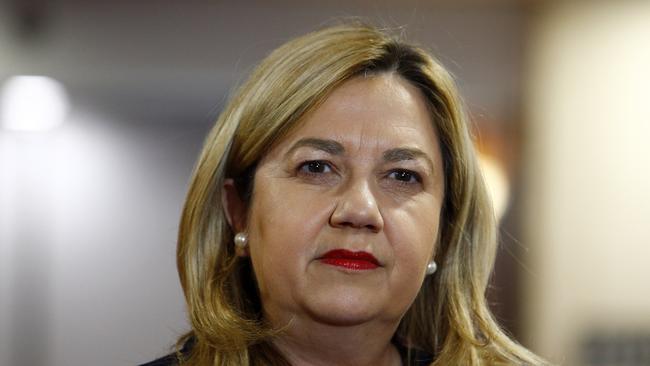‘She should go’: Queensland Labor’s ranks turn on Annastacia Palaszczuk’s leadership
Annastacia Palaszczuk has lost the confidence of key sections of the Labor Party in Queensland following one of the most damaging weeks of her eight years in power.

Annastacia Palaszczuk has lost the confidence of key sections of the Labor Party in Queensland after one of the most damaging weeks of her eight years in power, with internal concerns that the government will lose next year’s state election unless she quits as Premier.
Party rules prevent Ms Palaszczuk from being rolled as leader by her caucus, but several of her ministerial colleagues, backbenchers, and close allies are privately saying she needs to be convinced to go before October.
An early exit would give her replacement – likely to be senior Left faction members Deputy Premier Steven Miles or Health Minister Shannon Fentiman – a year to prepare for the election.
Right-faction Treasurer Cameron Dick is an outside contender.
Unrest over Ms Palaszczuk, who led Labor to election wins in 2015, 2017 and 2020, follows three successive published polls and internal ALP research showing her popularity is plummeting, with the state government headed for defeat in October next year.
The leadership chatter has been exacerbated by the Queensland government’s torrid week in parliament, with Ms Palaszczuk blamed for mishandling controversial youth crime measures.
Last-minute legislative amendments were rushed through parliament to make it legal to detain children in adult jails and police watch houses, dodging the usual parliamentary committee scrutiny and overriding the human rights act.
The changes were widely attacked by the state opposition, minor parties, legal advocates and policing experts.
The Weekend Australian spoke to several well-placed sources in Queensland Labor ranks who confirmed their concerns about Ms Palaszczuk’s leadership. They would speak only on condition of anonymity.
A Labor source said the party was “now in that zone” where Ms Palaszczuk’s future was a “substantial topic of conversation”.
“There’s a clear argument that – in the best interests of the government – she should go,” the source said.
Another ALP figure said the parliamentary week had been “shitful” and that “there’s increasingly a lot of chatter” about the need for a swift and orderly leadership transition, similar to West Australian Premier Mark McGowan’s retirement in May. “It seems unfair, but leaders (only) have a certain amount of time,” the Labor figure said. “Maybe she can turn it around but Queenslanders have really turned against her.”
But the figure said it was difficult to have conversations about who would replace Ms Palaszczuk when “she has made it clear she’s staying”.
“She’s never acted in a way that’s not best for her,” the ALP figure said. “And (Ms Palaszczuk’s partner) Reza (Adib) likes getting dressed up for all those events.
“It does feel like there’s an increasing amount of talk about it. And it (a leadership change) has to be done before October.”
A Labor MP said they attended a community event this week and were approached by several people who said: “She (Palaszczuk) has got to go”.
Another Labor MP said there was anger among the party ranks about the “ham-fisted” handling of the youth crime laws in parliament.
“Yes, there is a bit of talk about whether she should stay,” the MP said.
“There’s always a bit of talk, but after the week we’ve had …
“There’s no mechanism to remove her and she wants to stay.”
A separate senior Labor source said they were “worried and pessimistic” about the party’s chances at next year’s state election, but felt it was too late to change leaders.
“It would be crazy to push her out,” the senior source said.
“She has a great personal brand with Queenslanders, and Queenslanders like her.”
As recently as April, Ms Palaszczuk said she would “absolutely” contest the next election.
It is understood that she still has the support of union powerbroker Gary Bullock and state ALP president John Battams.
Ms Palaszczuk did not respond to a request for comment from The Weekend Australian.
In recent months, three polls published by three different media outlets have shown Labor’s primary vote falling behind the Liberal National Party’s first-preference support, and Ms Palaszczuk’s personal popularity flagging.
Last week, Nine’s Brisbane Times published a Resolve Strategic poll that showed the LNP’s primary vote rose to 38 per cent, eclipsing Labor’s 32 per cent for the first time. The survey also showed LNP leader David Crisafulli taking preferred premier status from Ms Palaszczuk for the first time.
The published results reflected earlier internal Labor research that also showed the Palaszczuk government was losing ground.
Mr Crisafulli and the LNP must win an extra 14 seats at next year’s election to win government in the 93-seat single-house parliament.
Under Labor’s constitution, it is very difficult to replace a sitting Labor state leader, unless it is in the aftermath of an election loss or they resign or become “permanently unavailable”.
At least 50 per cent of the parliamentary Labor caucus must petition the state secretary for a ballot.
Then, there are three separate votes to determine who should be leader: of the state parliamentary party, of eligible grassroots branch members, and of affiliated unions.
Labor’s Left faction is dominant in the Queensland party, meaning Mr Miles or Ms Fentiman would be the frontrunners in any leadership ballot to succeed Ms Palaszczuk.
Ms Palaszczuk, 54, became a Labor legend when she toppled one-term Liberal National Party leader Campbell Newman, unexpectedly winning the 2015 election.
For most of her tenure, her personal popularity has been one of Labor’s strongest assets.
Next May, Ms Palaszczuk will surpass former Labor premier Peter Beattie’s record as the ALP’s second-longest serving Queensland premier.
Mr Beattie was premier for nine years and 80 days.






To join the conversation, please log in. Don't have an account? Register
Join the conversation, you are commenting as Logout